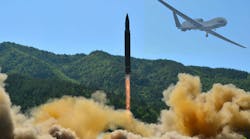Battlefields change as technologies evolve, and the combatants must adapt to the capabilities of available tools and weapons. As a present-day example, North Korea’s successful testing of an intercontinental ballistic missile (ICBM) with the United States within range, along with its nuclear capabilities, shows how advancing technology can create new threats. Surveillance provides a means of knowing about those threats in advance, using the latest technologies to spy on the enemy. And for both sides performing surveillance, it is more and more becoming a matter of machines spying on machines, with the humans working from a distance.
Surveillance once involved infiltration, which often meant trying to sneak troops or individuals behind enemy lines in order to gather information about an enemy’s plans. The risk was obviously high—troops could be detected, captured, and then subjected to interrogation for knowledge about the other side’s operations. These early forms of surveillance provided fodder for many grade-B films and novels based on espionage adventures, but they proved to be an inefficient means of gathering intelligence about an enemy.
Advances in technology, such as spy satellites, helped to improve the efficiency of spying efforts. These led to the development of technologies devoted to intelligence, surveillance, and reconnaissance (ISR) using various information-gathering electronic devices, such as visual and thermal cameras and sensors. One of the keys to successful ISR efforts was slipping these cameras and sensors behind enemy lines, and unmanned vehicles. In particular, unmanned aerial vehicles (UAVs), were found to be an effective means of keeping an “eye” on an enemy without putting humans at risk. While humans were still involved, they stayed behind at a control station to monitor and control the motions of the UAV during its ISR mission.
The use of UAVs for ISR has now become standard practice for most military forces, with many of the vehicles used for ISR missions capable of impressive flight times and long endurance. Since these vehicles and their collections of sensors and cameras are not inexpensive, the global market for ISR-based UAVs is quite healthy, and expected to grow at a steady pace for the next decade.
These ISR vehicles are becoming more “intelligent,” with tremendous computing and communications assets that allow them to process data from multiple sensors and cameras and transfer large amounts of intelligence at high data rates for dissemination across multiple armed forces and allied forces. Humans are still involved, but less and less, as the unmanned ISR vehicles become more programmable and more capable of operating automatically from great distances.
Many of the same companies that supply ISR-capable UAVs are also developing unmanned ground vehicles (UGVs) for the same purpose. Consequently, it is safe to say that future ISR missions will become more robotic in nature and more like video games, with human troops staying behind enemy lines to manage the controllers. Whether on the ground or in the air, many of these unmanned vehicles can also be equipped with warheads, explosive devices, and other weapons, so that what was initially an ISR mission can be turned into an offensive maneuver, with assaults being managed from many miles away. Humans are still involved, but they are more and more keeping their distances from the battlefield.

